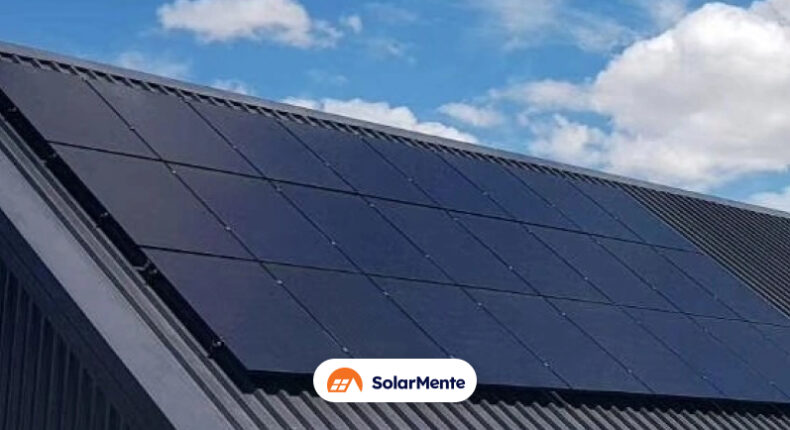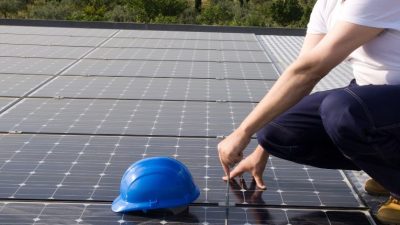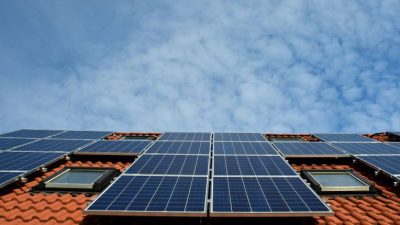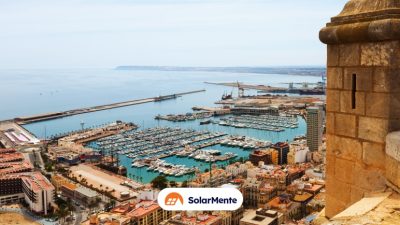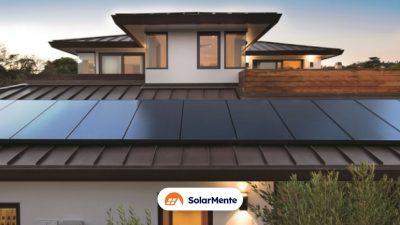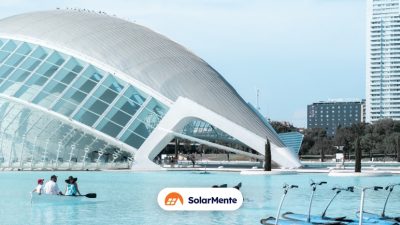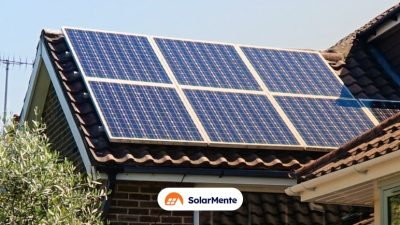When you start looking into the world of solar energy, you discover that there is a wide variety of types of solar panels.
And that can be overwhelming.
Because as the industry develops and the price of solar panels decreases, new technologies are coming onto the market.
In fact, according to the International Energy Agency (IEA), photovoltaic installations are becoming the most economical and energy-saving option, and are set to grow over the next few years.
And to achieve maximum savings it is important to know the types of solar panels that exist.
That is why in this article we will explain the different models of photovoltaic panels and we will show you a comparative table so that you have a better idea of which ones are most recommended for your installation.
Types of solar panels: general classification
Before looking at the types of photovoltaic panels, it is important to know the general classification.
Because when we talk about solar panels, we find the following groups:
- Photovoltaic solar panels: used to generate electricity.
- Solar thermal panels (or solar thermal collectors): their function is to heat the water used for heating or domestic hot water (DHW).
- Hybrid solar panels. It combines both technologies and is capable of generating heat and electricity, although it is still under development.
Types of photovoltaic solar panels according to technology
That said, we will define the types of solar photovoltaic panels based on the following criteria:
- Technology
- The dimensions
- The use
And we start with technology, the most widely used and best known. Here we distinguish the following models:
- Monocrystalline
- Polycrystalline
- Amorphous
We will go into detail on each of these technologies and explain the differences between them.
Monocrystalline
Monocrystalline solar panels are the model par excellence used in homes.
How can we tell them apart?
Good.
Silicon wafers for this type of cell are usually squares with corners cut with a chamfer.
But we can also easily distinguish them by their aesthetic black colour, which does not have a negative impact on the design of the façade.
Monocrystalline modules have a higher efficiency and performance than the other models.
In fact, they are the best performers at high temperatures. They are the ideal alternative for very hot geographical areas.
It also has the longest lifetime of 25 to 40 years, according to the American Solar Energy Society.
The best:
+ Higher efficiency
+ They take up little space
+ Good value for money
To be taken into account:
– The manufacturing process involves increased use of silicon.
– The price is higher than polycrystalline ones.
Polycrystalline
Polycrystalline plates also use silicon for their manufacture, but the method is different.
The silicon is melted and added to moulds that make up each solar module. These silicon blocks are left to solidify and are made up of small crystals of silicon.
It is a technique that does not require as much precision, so it is a faster procedure and costs less, but it is also less efficient.
To differentiate it from monocrystalline, the first striking factor is its uneven bluish colour.
Another characteristic feature is that there are no cut corners and therefore no blanks are visible on the front side as is the case with monocrystallines.
The best:
+ The price is cheaper
+ Long service life
To be taken into account:
– Take up more space
– They are less efficient
– They have less tolerance to heat
Thin-film panels
Although thin-film or thin-film solar panels are not the best known types of solar panels, it is also important to explain their characteristics.
It is true that their use is not feasible for homes or businesses, but they are used for industrial installations or utilities.
Even if we bring it to a more particular level, it is a useful technology for generating electricity in caravans, tents or boats, where high efficiency is not necessary.
And this relates to the next point: efficiency.
This is why it is used in this type of installation, its rates are low and this requires more space to install the solar modules.
On that basis, let’s look at how to differentiate it from the other models.
In the picture you can see its solid black colour without the peculiar contours of monocrystalline cells.
In short, the singularities of these technologies are:
- The manufacturing method is simple
- They are flexible and lightweight modules
- Need little active material
- Reduce energy costs
The best:
+ They are more economical
+ The installation process is simpler
+ Ideal for large facilities and utilities
To be taken into account:
– Its efficiency is low
– Its lifespan is shorter
Other types of photovoltaic solar panels
But these are not the only modules available on the market.
Thanks to technological developments, the sector is growing rapidly and expanding with new methodologies to make the most of the advantages of solar energy.
Here are some of the experiments currently being carried out:
- Photovoltaic glass or solar windows that take advantage of the structure of buildings to capture sunlight.
- Night-time panels. A study by the University of New South Wales (Australia) has developed a technology to generate electricity when the sun is not shining thanks to the infrared heat present on Earth.
- Flexible panels: an interesting option when a portable, lightweight, low power source is needed.
It is only a start and its efficiency is lower than the previously mentioned panels, but it is evolving rapidly and a road full of changes awaits us where efficiency will increase.
Differences between monocrystalline, polycrystalline and thin-film plates
Having presented the types of photovoltaic solar panels and their characteristics, let’s look at the differences between them, based on the following factors:
- How they are made
- Efficiency
- Design
- Cost
Method of manufacture
Monocrystalline panels are manufactured using the Czochralski method. Each cell consists of a silicon wafer made of a single crystal of silicon.
Here is a step-by-step guide to the process:
- The crystal is placed in a kind of pure silicon bath which melts at high temperatures.
- The seed is extracted and a crystal is created from the molten silicon that forms around it.
- Finally, the ingot is cut into thin sheets for the production of solar modules.
Polycrystalline wafers, on the other hand, are formed from silicon crystal fragments which are melted in the same mould before being cut into wafers. This is why they are characterised by a bluish hue.
What about thin film panels?
Unlike the two previous ones, they are made of different materials.
First, the most common is the panel generated from cadmium telluride (CdTe). To manufacture it, a layer of this material is placed between other conductors that help to capture sunlight. In addition, a layer of glass is added on top for protection.
Another commonly used material is amorphous silicon.
For the sake of clarity, it has a similar composition to monocrystalline and polycrystalline.
What is the difference?
They are composed of non-crystalline silicon on plastic, glass or metal.
And there is one last option: thin-film panels made of copper indium gallium selenide (CIGS).
These materials are placed between conductive layers which can be glass, plastic, steel or aluminium, and in order to capture electrical currents, electrodes are placed on both the front and back of the material.
But how efficient is each model?
We will see that now.
Efficiency
It is time to know the efficiency of each type of solar panel.
They can be broadly classified as follows:
- Monocrystalline panels are the most efficient with percentages between 20% and 23%, according to NREL.
- Efficiency of polycrystalline panels: between 15% and 17%.
- Efficiency of thin-film panels: between 10% and 13%.
Why are monocrystallines more efficient?
Because they are built with a single silicon crystal, electrons have an easier time flowing through the cells, making them more efficient.
This higher efficiency translates into the use of a smaller space to achieve a certain power output, which is a good thing and, therefore, is the most commonly used in homes where space is limited.
However, polycrystalline modules are composed of multiple silicon crystals in each cell and this makes it difficult for electrons to pass through and therefore efficiency drops.
But watch out for developments in the field.
Because thanks to this, polycrystalline panels are approaching the efficiency of monocrystalline panels. We are talking about improvements that have made it possible to move up to cells of more than 300 watts.
And thin film panels are not far behind.
The Swiss Federal Laboratory for Materials Science and Technology (EMPA) has achieved a new efficiency record of over 22%.
This will allow no more thin-film solar panels to be installed to produce the same amount of electricity as a mono or polycrystalline one.
This is why they are not often used for residential use, where space is at a premium.
But it is a good option for large-scale installations, where capacity limits are not an issue in meeting energy demand.
And if we talk about its useful life, it is shorter than other types of solar panels. This means that degradation is accelerated and the elements need to be replaced in less time.
Design
The appearance of the panel varies by materials and production method.
If you walk down the street and look at the roofs, you will see that most photovoltaic installations are made up of black modules. This means that it is most likely a monocrystalline panel.
When light comes into contact with pure silicon, it takes on this black colour.
The frames are usually black or silver, and the backing film is usually black, white or silver.
However, polycrystalline cells acquire a bluish hue because they are composed of different silicon fragments. Like the previous ones, they have different colours in terms of frames and rear laḿines. In the first case, the common colour is silver, while the sheets can be white or silver.
And finally, there is the design of the thin-film panels.
The appearance is quite different and its distinguishing feature is the thin coating of this model, coupled with its flexibility, and it is characterised by a solid black colour.
Temperature coefficient
Temperature is an important factor in the performance of solar panels.
Photovoltaic modules are tested under a standard temperature coefficient which shows the point at which the efficiency decreases due to increasing temperatures.
Based on the assumption that heat is detrimental to a solar panel, monocrystalline panels have a lower temperature coefficient, i.e. they work better at higher temperatures (the stated optimum is 25°C).
In the technical data sheet of the solar panels, you will find the Temperature Coefficient data expressed in %/ºC.
But how do we know what this means?
We explain.
This percentage indicates the power lost by the solar panel for each degree of temperature above 25°C.
Look at the table below:
Polycrystalline P-Type cells – 0.39 to 0.43 % /°C
Monocrystalline P-Type cells – 0.35 to 0.40 % /°C
Monocrystalline N-type TOPcon – 0.29 to 0.32 % /°C
Monocrystalline N-Type IBC cells – 0.28 to 0.31 % /°C
Monocrystalline N-Type HJT cells – 0.25 to 0.27 % /°C
Do you see how the coefficient of monocrystalline is lower than polycrystalline?
This means that the monocrystalline plate is more efficient in hot climates.
And beware, because there is a myth surrounding this factor.
High temperatures do not contribute to a higher solar energy yield, but it is the daylight hours that do. Therefore, the more sunlight the better.
Cost
The manufacturing cost of a monocrystalline panel is more expensive, hence the higher efficiency and power which drives up the price.
In any case, this price has nothing to do with what it was years ago. The constant evolution in the sector has made it possible to reduce manufacturing costs and reduce the price, so that the difference with polycrystalline panels is not abysmal.
It is true that polycrystallines are cheaper, because the manufacturing process is simpler, but in terms of performance they are inferior.
And that is why monocrystalline has become the ideal choice for residential use.
What can we say about thin-film modules?
They are undoubtedly the cheapest of the PV panel types, but of course this is reflected in their low efficiency.
Positive factors include its simple installation process and low cost, making it an ideal choice for large-scale projects where space is the least of the problems.
In short:
- Monocrystalline solar panels show the highest efficiency, but they are also the most expensive.
- Polycrystallines are more economical, but their efficiency is also reduced. In addition, they differ from monocrystallines in their bluish colour compared to the black of monocrystallines.
- Thin-film cells are cheaper, lighter and more flexible, but their efficiency is the lowest and therefore their lifetime is shorter.
Comparison of the types of photovoltaic panels
| Panel type | Monocrystalline | Polycrystalline | Thin film |
| Efficiency | 17% a 23% | 15 a 17% | 10 a 13% |
| Performance | High | Medium-high | Under |
| Design | Black | Blue | Black or mixed? |
| Cost | Higher | Cheap | more economical |
At SolarMente we work with monocrystalline panels for residential use and these are the manufacturers we use:
- Huawei
- JA Solar
- Hyundai
Types of photovoltaic solar panels according to use
We switch to another categorisation and now we are going to look at the types of panels according to use, these can be:
- Residential use
- For industrial use
- For large-scale projects (solar farms or public services)
It is important to clarify that depending on the use, the size varies.
We cannot compare those used for residential use with those used for residential use.
But don’t worry, we talk about dimensions in the next category.
Types of photovoltaic modules based on size
We show a final categorisation according to size:
- 60 cells per module
- 72 cells per module
The 60-cell modules are intended for residential use, whereas the 72-cell modules are intended for large installations where higher energy consumption is required.
This does not mean that modules with 72 cells cannot be used in residential applications, but this is not the norm. However, the power of this larger number of cells in residences is higher than those used in industry.
The use of fewer cells is applied to small isolated installations of small power and working with 12 volts voltage.
What type of panel is best for your home?
Thanks to the unstoppable rise of solar energy, it is nowadays more possible to opt for a self-consumption installation in our home.
But as we have seen in this article, not all types of solar photovoltaic panels are suitable for this.
The most commonly used for housing are monocrystalline due to their high efficiency.
However, this does not mean that other panels are not valid, but that their use is oriented more towards areas where space is not a requirement, such as large installations or small installations such as caravans or boats.
Choosing the right model will allow you to save more every month on your electricity bill and reduce your return on investment.
Whether:
- You buy (or finance) your installation
- You rent your solar panels
We will make a preliminary study without any commitment and personalised.
And we’ll tell you how much you can reduce your electricity costs.

